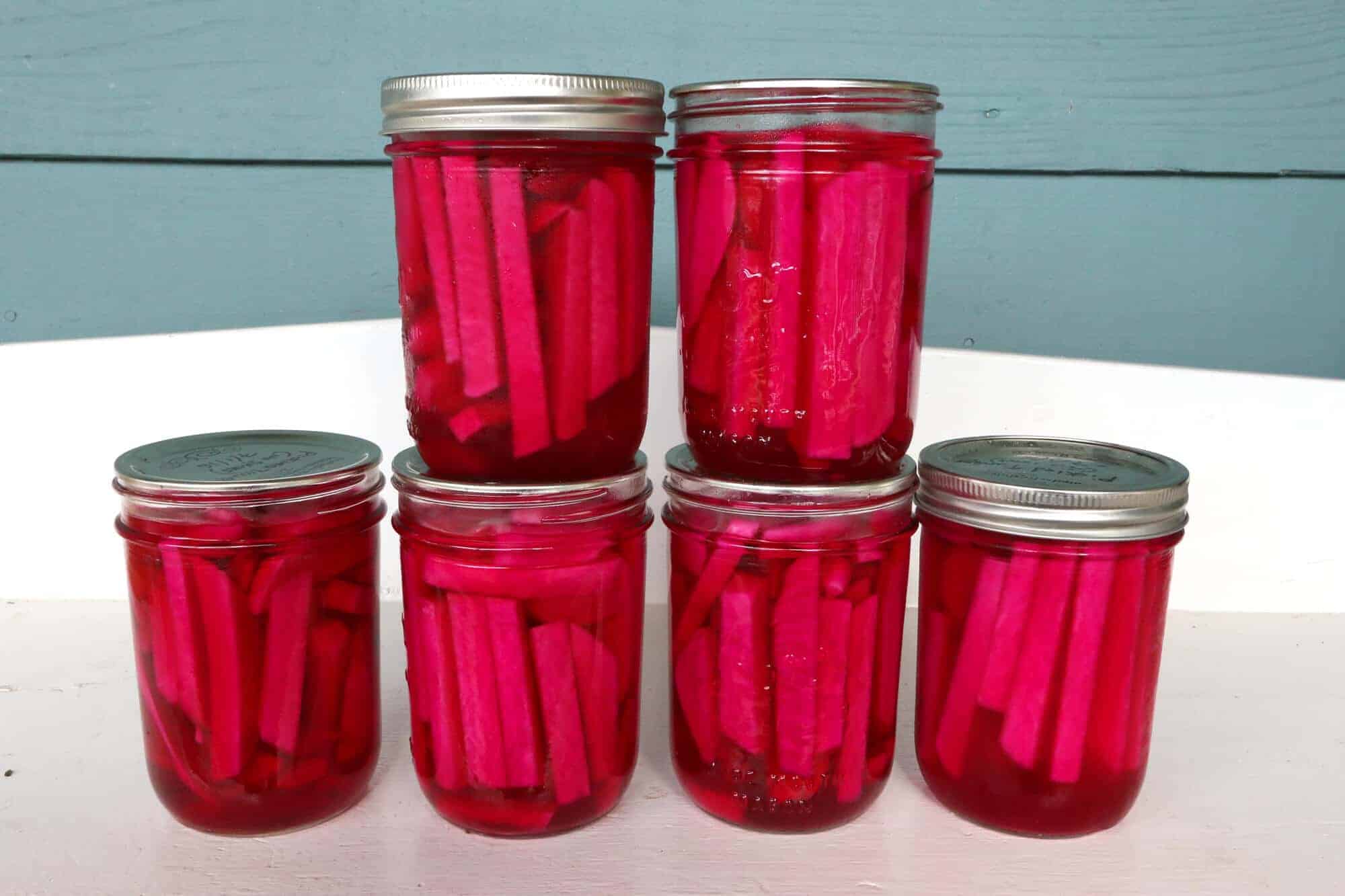
Pickling is a method of preservation that dates back to Neolithic times around 7000 BC. During this anaerobic fermentation process strange and wonderful things happen that transform the original product into something quite different. And very healthy with all those probiotics.
So why not turnips? Yes, turnips. Pickled. Excited yet?
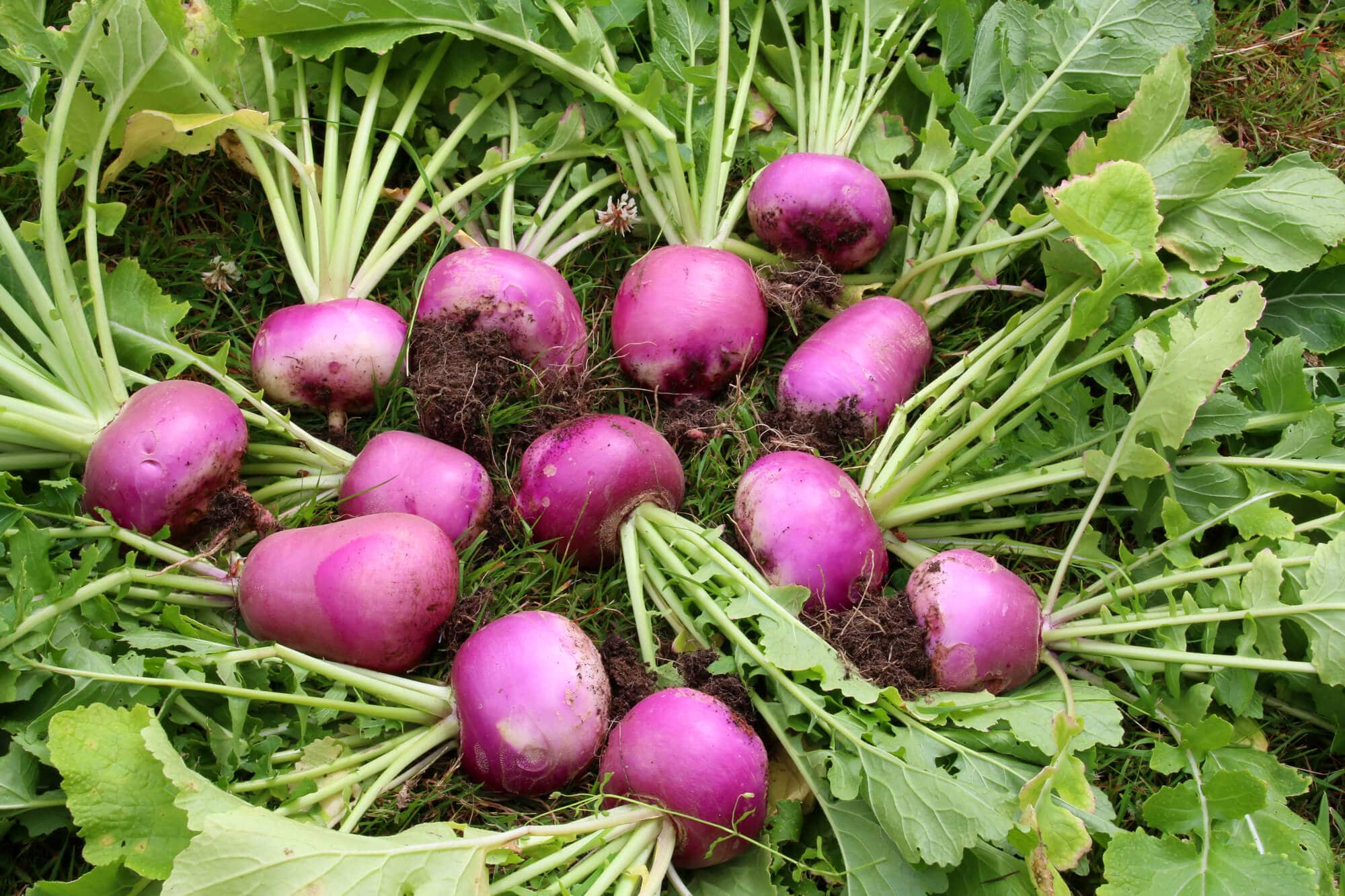
If you’ve never tried them you really should give them a go. They’ve been a staple food in the Middle East forever, particularly in Lebanon, Egypt and Syria, accompanying a whole array of dishes from breakfast to dinner. Pickled turnips are one of those simple, humble ingredients that can boost the flavor of certain dishes up by several notches. Or they can enhance the experience of a meal by serving them as a table condiment and popping them into your mouth between bites.
Try setting them out in a bowl on the dinner table like you would a bowl of pickles, peppers or olives and see what happens.
And they’re an especially great side to serve with Middle Eastern dishes like baba ganoush, hummus, flatbread, in falafels and in shawarmas.
I grew a bunch of turnips for the first time this year and am impressed by how easy and fuss-free they are to grow. They pretty much just do their own thing, even in the midst of competing weeds, and produce a beautiful crop.
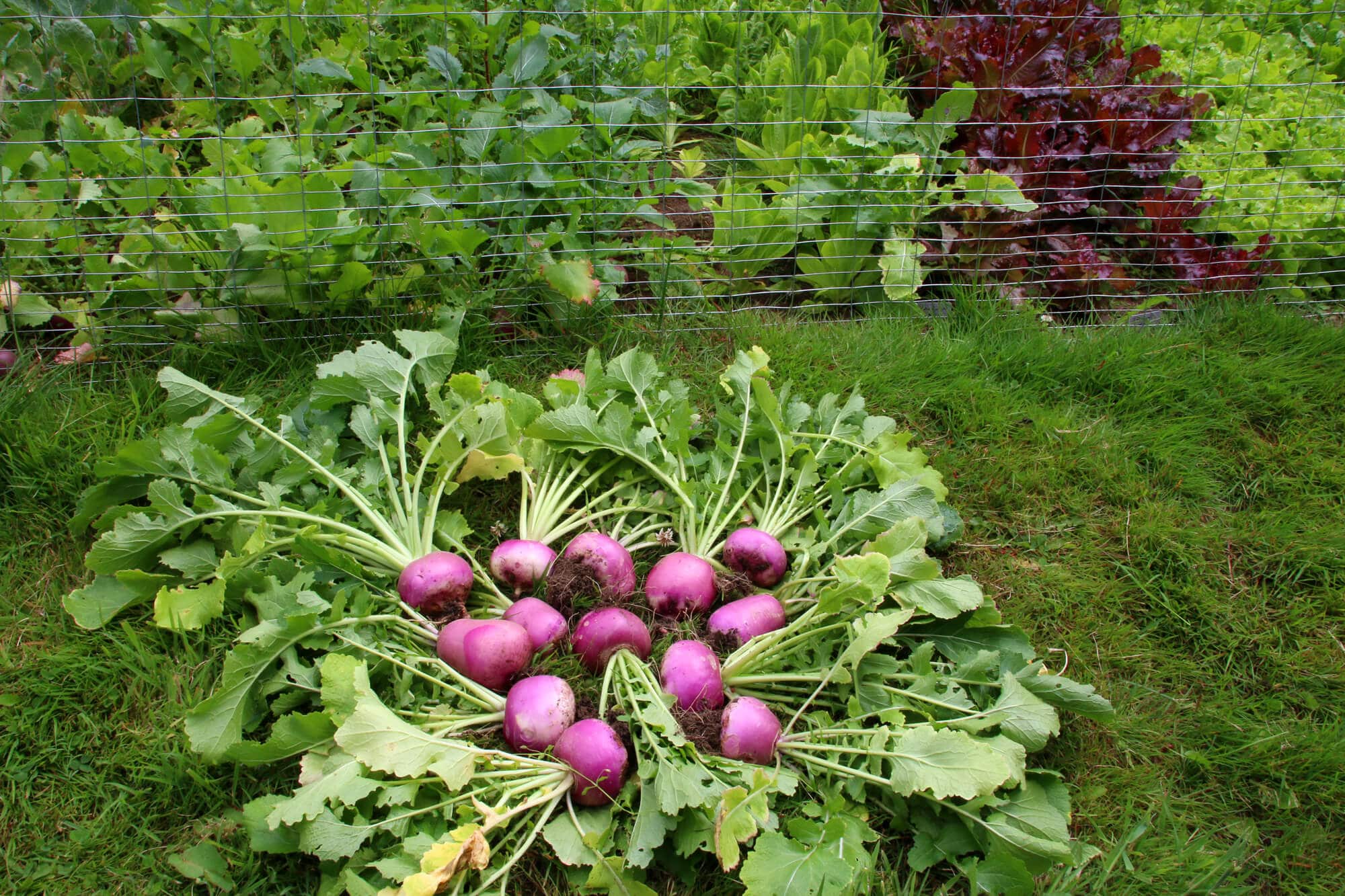
With such a generous crop of turnips I’ve been experimenting more with these normally neglected root vegetables and have come to appreciate them quite a lot. Their mild flavor and pleasant crunch lend themselves perfectly to salads and I’ve been making a variety of oil and vinegar salads with them as well as adding them to other salads.
They’re also terrific baked or roasted alongside chicken. And have you ever had them pureed like mashed potatoes? They’re great!
But I still had a lot of turnips leftover and wanted to make good use of them and find a way to store them up for the Winter. What immediately came to mind was pickled turnips like the kind I was introduced to when I was doing a study abroad in Israel and frequently enjoyed when devouring shawarmas at Middle Eastern restaurants in Europe.
Incredibly simple to make, pickled turnips are an unexpectedly delicious way to put this root vegetable to use!
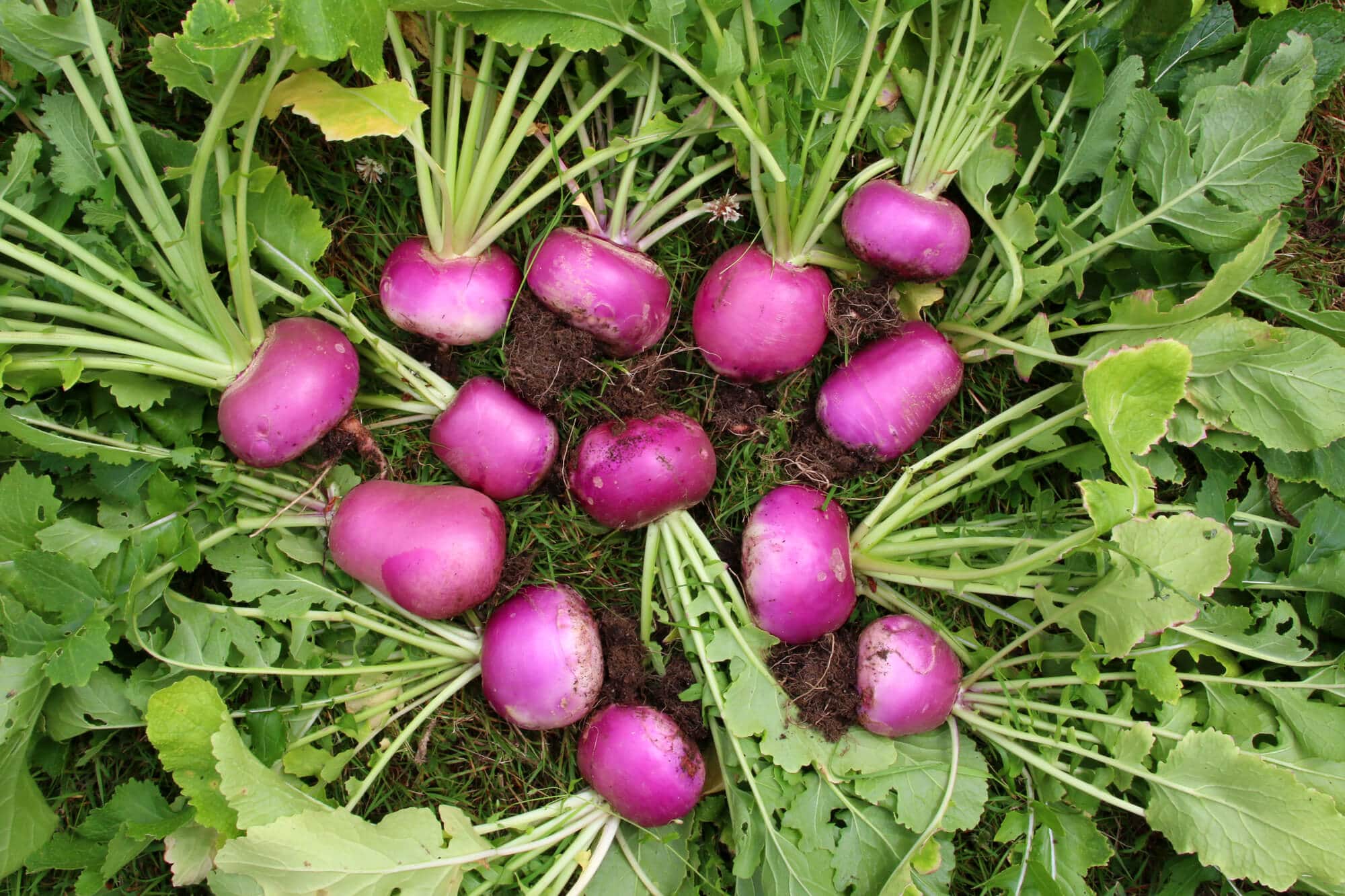
Let’s get started!
First we’re going to make the bring and all you have to do is add all the brine ingredients to a medium stock pot and bring it to a boil. Reduce the heat to medium, cover and simmer for 10 minutes. Let it cool completely.
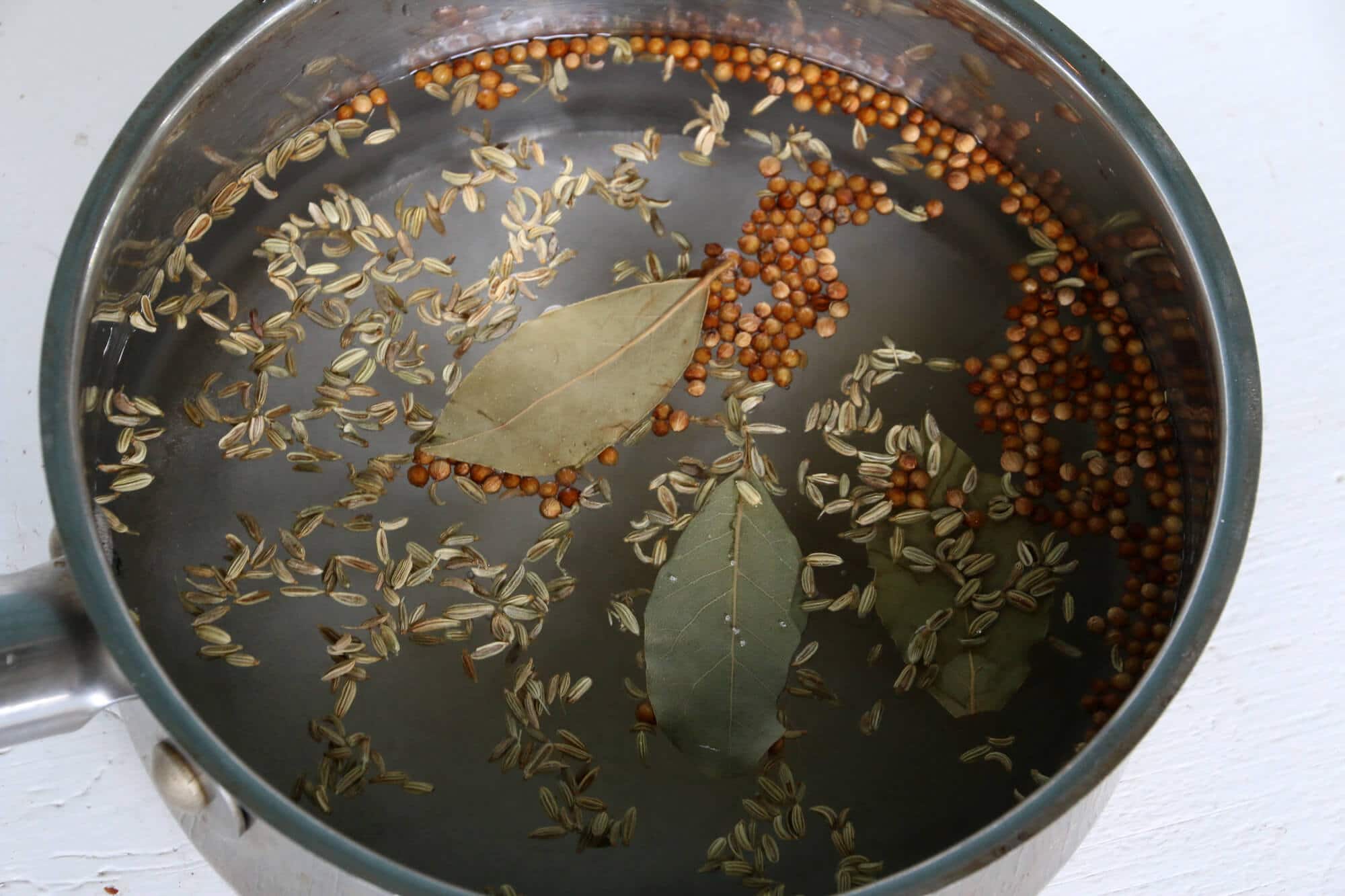
Peel the turnips and cut them into spears or slices, whichever you prefer.
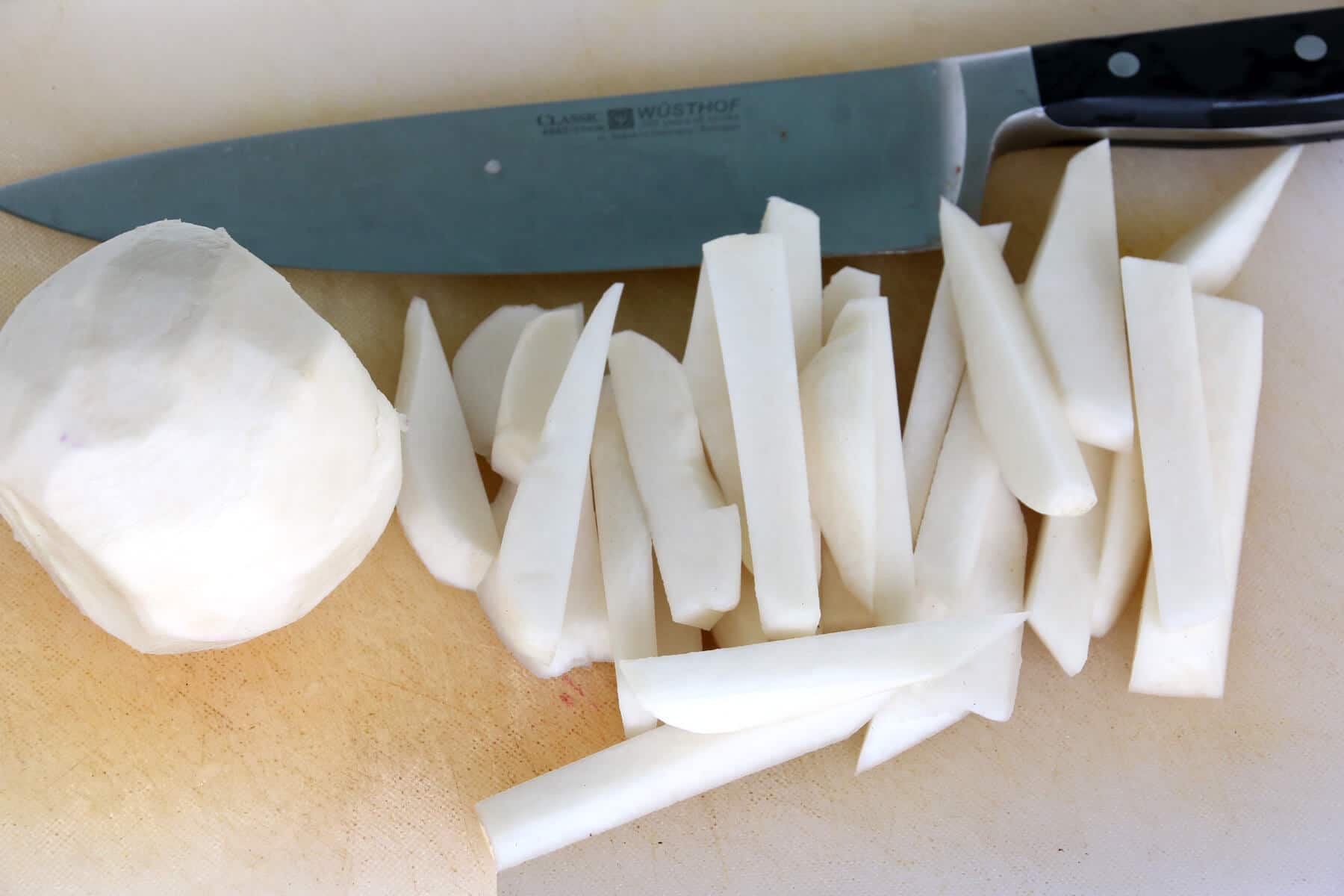
Slice up a a large beet or two small beets. Beets are traditionally used for pickled turnips, they make them visually more appealing. Over time the color becomes a vibrant neon pink.
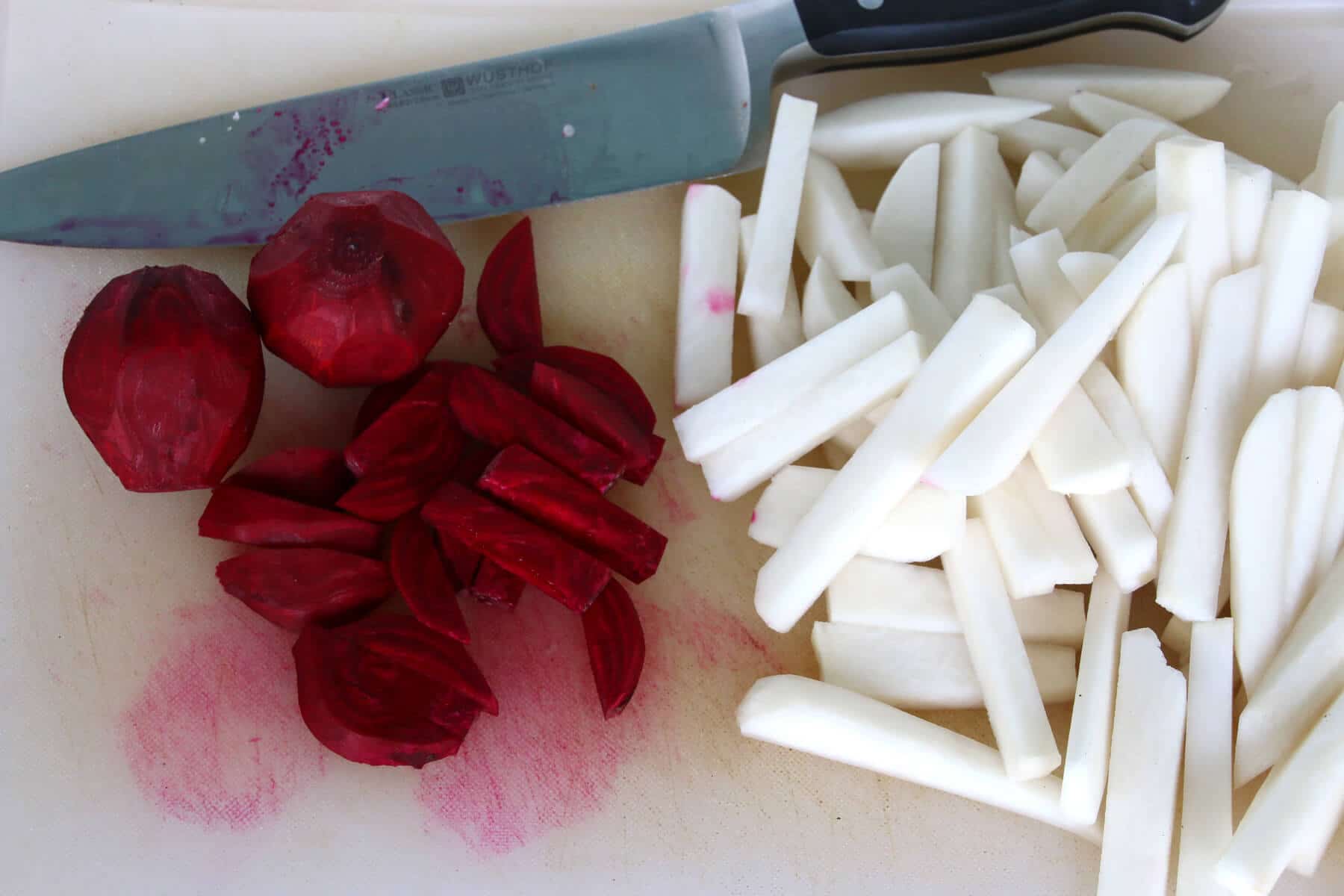
Pack the turnips and a few slices of beet along with a clove of garlic into sterilized glass jars.
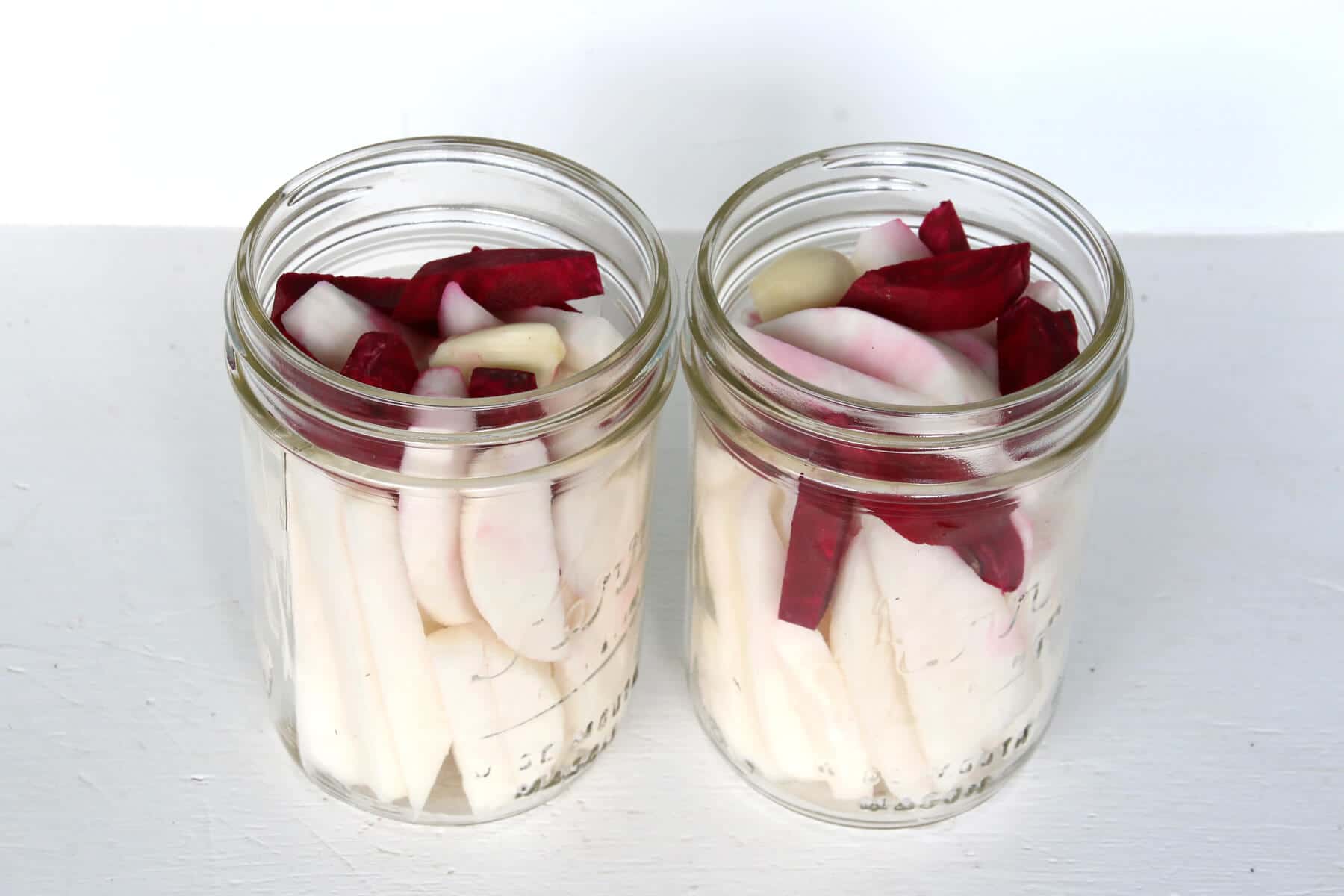
Pour the brine over them, covering them completely and leaving 1/2 inch headspace from the top of the jar.
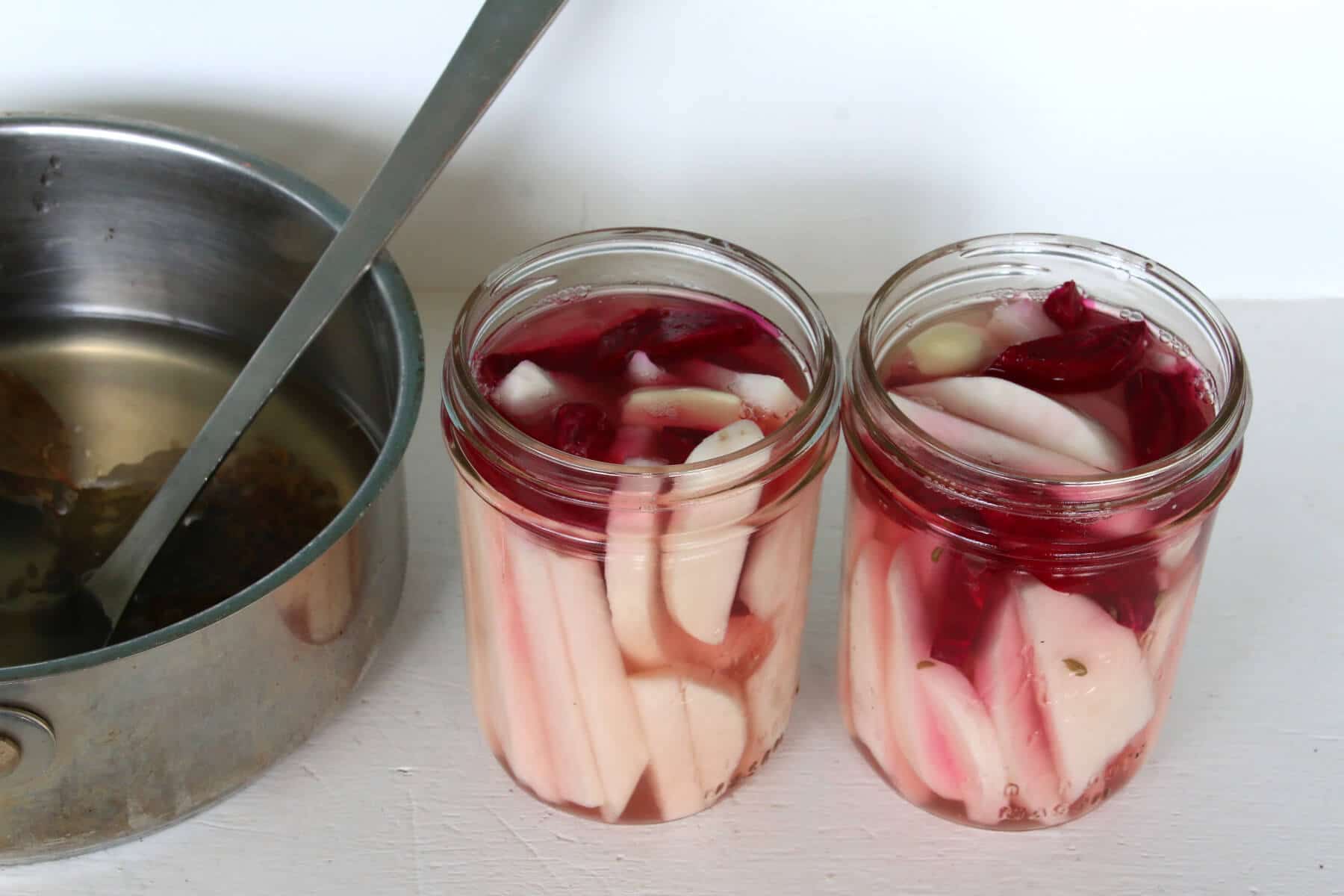
Screw on the lids. Let the pickled turnips sit in a relatively cool place for a week to enable to fermentation process. Then store them in the refrigerator and ideally eat them within two months. Using this method will result in a more interesting and complex flavor than canning them.
If you are canning them for long-term storage: Add the brine to the sterilized jars while it’s still hot, covering the turnips completely and leaving 1/2 inch headspace from the top of the jar, and screw on the lids. Process in a boiling water bath for 10 minutes then remove the jars and let them sit undisturbed for 24 hours before moving them. Store them in a cool, dark place for up to a year (for maximum flavor and texture use within 6 months).
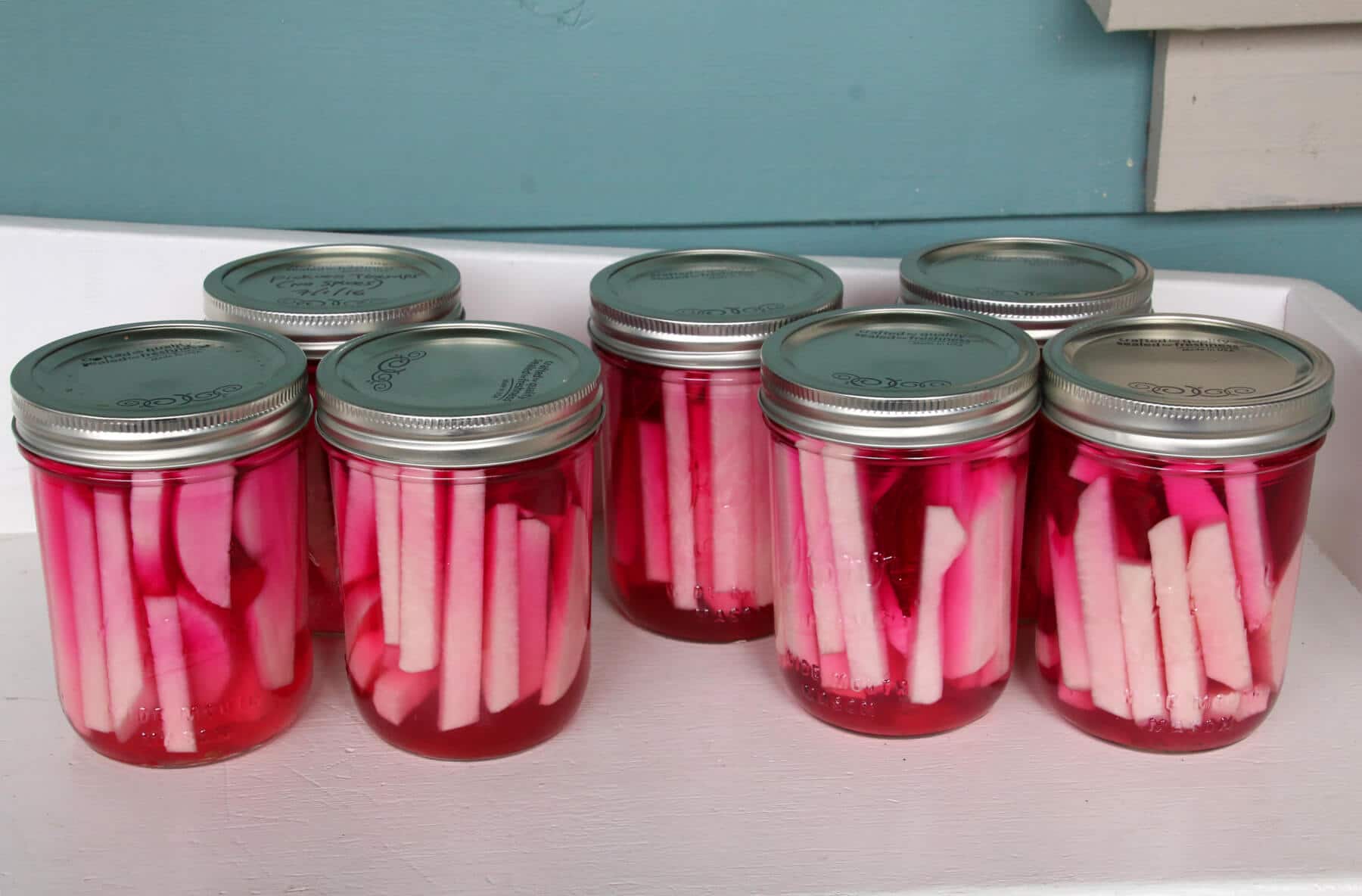
Initially light pink, the color intensifies within a few days, as does the flavor, and within a couple of weeks they’re ready to eat.

Serve these pickled turnips in a bowl at the dinner table as you would regular pickles, peppers or olives. They’re an especially great side to serve with Middle Eastern dishes like baba ganoush, hummus, flatbread, in falafels and in shawarmas.

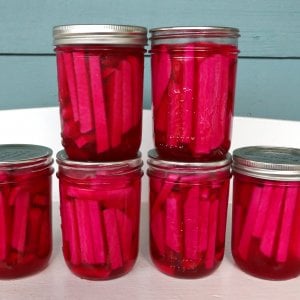
Pickled Turnips
Ingredients
- 3 pounds fresh, firm turnips , peeled and cut into about 1/3 inch sticks or slices
- 1 large red beet ,peeled and cut into about 1/3 inch sticks or slices
- A peeled garlic clove for each jar
- For the Brine:
- 3 bay leaves
- 1 tablespoon fennel seeds
- 1 tablespoon coriander seeds
- 2 cups white vinegar
- 3 cups water
- 1/2 cup kosher or sea salt (avoid regular table salt, it imparts a bitter flavor)
Instructions
- Place the brine ingredients in a small saucepan and bring to a boil. Reduce to medium, cover and simmer for 10 minutes. Let cool completely.
- Stuff the turnips into sterilized jars along with a few pieces of beet and a clove of garlic and add the brine, seeds and all, to fully cover the turnips and leaving 1/4 inch headspace from the rim of the jar. Screw on the lids. (*See note for instructions on canning the turnips.)
- Let the pickled turnips sit in a relatively cool place for a week to enable to fermentation process. Then store them in the refrigerator and ideally eat them within two months. Using this method will result in a more interesting and complex flavor than canning them.
- If you are canning them for long-term storage: Add the brine to the sterilized jars while it's still hot, covering the turnips completely and leaving 1/2 inch headspace from the top of the jar, and screw on the lids. Process in a boiling water bath for 10 minutes for pint sized jars then remove the jars and let them sit undisturbed for 24 hours before moving them. Store them in a cool, dark place for up to a year (for optimal flavor and texture, use within 6 months).
Nutrition
edward says
Hi can you please tell me how these taste with the fennel and coriander seeds? You are the only recipe out of 6 other recipes
Kimberly @ The Daring Gourmet says
Hi Edward, if you’re worried about the flavor being too strong, it’s a very subdued/mild flavor.
Cindy Barton says
This recipe is way to heavy in salt. Had to throw everything away, we could not eat them. Complete waste of my turnips.
Kimberly @ The Daring Gourmet says
Hi Cindy, I’m sorry it wasn’t to your taste.
Anonymous says
Could you provide how many jars this recipe will make and what size jar?
Ta
Kimberly @ The Daring Gourmet says
This makes about 6 pints.
N says
I made this recipe as directed and there wasn’t nearly enough liquid for me to get a full six pints. I had to double the brine recipe. Shouldn’t there be some water in the bring, not just vinegar? I don’t see how you got six pints with only 2 cups of liquid. Surely there must be a mistake in your recipe.
Kimberly @ The Daring Gourmet says
Hi, I apologize for that oversight, I’ve just updated it. Some traditional recipes call for all vinegar while others dilute it with water. I’ve used and like both methods. You can adjust the ratios according to your taste preference but for safety you’ll never want to go below a 3 to 1 ratio (3 parts water, 1 part vinegar), though I personally prefer a higher vinegar content.
Erik Shanton says
Wow, glad you updated the recipe. I made these in February before the water was added to the recipe, and they were delicious, but too salty to eat. I’m going to try again now. Your recipe is one of the only that I could find for water bath canning the turnips, which I like doing rather than just fermenting them.
Kathy Bassett says
My Syrian grandmother served these cut up small to put over lentils and rice
Kimberly @ The Daring Gourmet says
They contribute such a great flavor dimension, Kathy, thanks for sharing!
Angie | Big Bear's Wife says
I love how bring the pink is! I need to find some turnips at the farmer’s market!
Jenny Thielemann says
Fantastic, thanks!
Jenny Thielemann says
I understood that turnips are a low acid food, and not safe to can with a water bath. Is this not true?
Kimberly @ The Daring Gourmet says
Hi Jenny, if you’re canning them on their own without the addition of acid yes, that’s true. But that’s the purpose of the high quantity of salt and vinegar which makes the turnips safe for canning via the water bath method. (Same thing with canning other low acid foods like pickles and relish where you add the acid in the form of salt and vinegar.)
Des @ Life's Ambrosia says
I am loving this color! I don’t use turnips nearly enough, usually only as an add in to broth. i need to try this!
Aly ~ Cooking In Stilettos says
I would love to try these with a bit of hummus – they look amazing!
Kaitie says
This looks absolutely amazing! And so easy! I actually should try this :)
Lauren Kelly Nutrition says
These are amazing! I am loving the color!
Rebecca @ Strength and Sunshine says
Perfect way to preserve them for the winter! How delicious and vibrant!
Kim Beaulieu says
These are so cool. My dad was a huge fan of turnip. He would have loved this.
Debra @ Bowl Me Over says
Those are just gorgeous!!! I love to do canning, though mostly do jams & jellies. I definitely want a jar of these!! Your garden looks just lovely too. Can you eat the tops of the turnips? Just curious as they are so beautiful & green!!
Jane says
Yes, turnip tops make a great vegetable like unto spinach. Make cornbread dumplings to cook in turnip “pot liquor”. Delicious